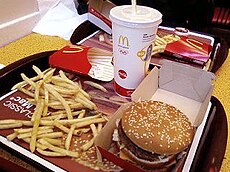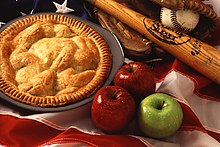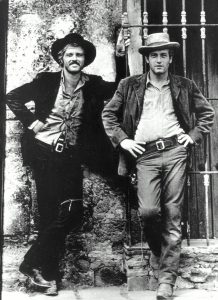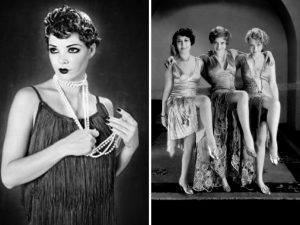AMERICAN CULTURE

Americans are very proud of their country. American culture and society are founded on freedom, equal rights, and democracy. Americans value the idea of free speech. This means that they can say whatever they want about the president. They protest when the government does things they don't like. The development of America's culture—film, music, dance, architecture, literature, food, and the visual arts—has been shaped by many diverse sources.
American popular culture has been expressed through all media and signals, including movies, television, music, comics, and sports. Gone with the Wind and Star Wars, Mickey Mouse and Marilyn Monroe, Sesame Street, SpongeBob and The Simpsons, Elvis Presley, Michael Jackson, Madonna and Britney Spears, jazz, blues, and hip hop, Popeye, Snoopy and Superman, baseball, football and basketball, Barbie and G.I. Joe, Burger and Coke etc. —These names, genres, and phrases relate to American products that have been expanded around the world.
It is important to note that the United States tends to be an exporter of culture, as well as absorbing other cultural traditions relatively easily, such as soccer, pizza, and yoga. This marks a very great contrast to the early days of the United States. The country's cities offer classical and popular music, historical and scientific research centers, museums, musicals and plays, as well as artistic projects and international architectural works. This development is the result of contributions from private philanthropists, as well as from the government.
regional variations
The journalist and writer Colin Woodard, in his book American Nations (2011), 1 affirms the existence of eleven regional cultures in North America, based on the cultural characteristics of the original settlers of these regions. According to Woodard, those regions would cross and bypass the formal borders of states or even the country. These regions are:
Yankeedom - Yankeedom encompasses New England, much of New York State, and much of the industrial Midwest, extending into Michigan, Wisconsin, and Minnesota. Areas that were initially settled by the East Anglian Puritans and their descendants. It is characterized by a strong sense of community, the valorization of education, citizen participation in government, and the assimilation of outsiders.
New Netherland - comprises the New York City metropolitan area - encompassing the city itself, as well as northern New Jersey and part of Connecticut. The area was settled by the Dutch before they were driven out by the English. The region inherited the capitalist, cosmopolitan and tolerant culture implanted by the Dutch in New York. Today, the region is a hub for global trade
Middlelands - Settled by English and Welsh Quakers, it is a welcoming middle-class society with outsiders and spawned the "American Heartland" culture. It extends to Pennsylvania, Ohio, Iowa, Kansas, Nebraska, northern Indiana, northern Illinois, northern Missouri, and southern New Jersey. It is an ethnically diverse and pacifist culture.
Marea - Built by the English gentry in the area of present-day Maryland, Virginia, and North Carolina. It is where the federal capital, Washington, DC, is located. It had its beginning in the colonial era as a society with feudal remnants of the English metropolis and that adopted the slavery of African Americans. It is an aristocratic culture that values authority and tradition.
Greater Appalachia - Settled by British from war-torn lands in Ireland, Scotland, and northern England, the Appalachian region encompasses parts of Kentucky, Tennessee, West Virginia, Arkansas, Oklahoma, southern Missouri, southern Indiana, southern of Illinois and North Texas. It is the most warmongering region in the United States, with a strong "warrior culture."
Deep South - Settled by English slavers from Barbados, it was conceived as a West Indian-style slave society. Includes Alabama, Mississippi, Georgia, South Carolina, northern Florida, and eastern Texas. It has a very rigid social structure and historically opposed the North in the American Civil War and implemented segregationist policies against African Americans.
El Norte - Comprised of the US-Mexico border region, it is "a place apart" from the rest of the United States. It has parts of Texas, Arizona, New Mexico, and California. In a broader context, considering all of North America and not just the United States, Mexico (former New Spain) is also included, mainly the northernmost states of this country.
GASTRONOMY

The popular hamburger is a clear example of a dish identified with the United States and that has an origin in European cuisine. Many sugary drinks are also drunk. Fast food restaurants like McDonald's or Burger King have expanded worldwide. 
Louisiana Creole cuisine, one of the most popular in the country. The predominant cuisine in the United States is similar to that of other Western countries. Wheat is the main cereal grain. Traditional American cuisine uses ingredients such as turkey, venison, deer, potatoes, sweet potatoes, corn, and maple syrup, foods eaten by Native Americans and early Europeans. Pork and barbecue, French fries and chocolate chip cookies are trademarks of American food. Soul food, created by slaves from Africa, is popular with Southern Americans and most African-Americans. Syncretic cuisines, such as Louisiana, Cajun, and Tex-Mex, are the most important in the region.

Sirloin accompanied with some vegetables: carrots, snow peas, broccoli.
Iconic American dishes like apple pie, fried chicken, hamburgers, and hot dogs derive from recipes from various immigrants. In addition, French fries, Mexican dishes such as tacos, and Italian pasta have entered the market. Americans often drink coffee or tea, and more than half of the adult population drinks at least one cup a day. The market of American industries is what has caused orange juice and milk to be the beverages consumed for breakfast. During the 1980s and 1990s, the average number of calories consumed per day by Americans increased by 24%; this is due to the creation of fast food outlets, also unleashing the so-called "obesity epidemic". Non-alcoholic drinks are also very popular; sugary ones provide 9% of the calories consumed per day.

Apple pie is one of the most representative icons of American gastronomy
People usually eat with cutlery (fork, knife and spoon), unless they eat sandwiches, hamburgers or fast food. They use their own plates or bowls for each meal instead of sharing a single bowl or plate. If you have a guest over, you can offer them their food on a separate plate. If you have questions about whether the food is shared or for one person, you can ask.
CLOTING - FASHION

Young man in jeans, popularized in the second half of the 20th century. Its use has transcended borders, becoming an element of clothing throughout the world. In addition to the business and the various textile companies, fashion in the United States is eclectic and predominantly informal. Jeans were popularized as workwear in the 1850s by tradesman Levi Strauss, a German immigrant from San Francisco, and were adopted by several American teenagers a century later. They are currently a garment used on all continents by individuals of all ages and all social classes. Along with casual fashion in general, jeans are the main contribution of American culture to world fashion. The country is also home to the creators of several textile companies, such as Ralph Lauren and Calvin Klein. Companies such as Abercrombie & Fitch, American Eagle, Hollister, Nike, Converse, Vans and Eckō are considered niche markets.
The cowboy style originates from the 19th century by the inhabitants of the State of Texas. The clothing was adapted to the rough life and work of the men of the region. It consists of the following garments:
Blue jeans: They are pants made with cotton and elastane to give them resistance.
Wide brim hat.
Boots of the common type, which are distinguished by having a height up to the middle of the calf and a rectangular heel of 3 centimeters, and lacero boots that are characterized by heels of a maximum height of 2 centimeters.

.
PIN-UP
A pin-up style woman dressed provocatively. They used to be distinguished by the use of patterned skirts, wearing bare shoulder and low-cut garments. Pin-up has its origin in the term that refers to photographs and illustrations for magazines.
The models who used to appear in them with the provocative style were associated with a particular style and way of dressing. It was a trend in the 40s in the United States and was reflected in the magazines that were sent to American soldiers who went to World War II.
FLAPPERS
Flapper women were distinguished by their unconventional style of dress. A flapper was a woman who was characterized by an unusual lifestyle on the feminine for the first decades of the 20th century. Flapper women used to have habits like attending jazz music bars where they drank, danced and smoked.
Flapper Style Features:
 Short hair
Short hair
Cloche fitted hat, made of felt, with a cylindrical body
Straight and loose dresses with a wide neckline
Makeup on the knees to shine at the dance
SPORT
As far as popularity is concerned, there are four dominant sports in the United States: American football, basketball, baseball, and hockey. These four sports generate large television audiences and move a significant volume of business through their respective national championships, with the Super Bowl being one of the most followed events of the year. At the student level, most high schools have teams for football, basketball, swimming, track, baseball, soccer, and tennis.
Baseball is one of America's favorite sports..
American football match of the National Football League.
OLD PEOPLE
In the US, seniors are those who are 65 years of age or older. At age 65, Americans can stop working and receive a pension or a small retirement salary from the government. The United States is different from many other countries because older Americans typically live alone or in institutions. About 29% of Americans over the age of 65 live alone, and 47% of women over the age of 75 live alone. Many others live in nursing homes. You may feel that Americans, especially young Americans, do not respect the elderly in the same way that they do in your culture. In the United States, this is sometimes known as the "generation gap." The young and the old may have different opinions, as they do in other countries, but the American media tends to focus on the youth. In the US, the elderly often face financial and health difficulties. Immigrants and refugees who are elderly also have to face these kinds of difficulties. If you are an older person, you may have thought that the US would give you more care than you are receiving. However, you may need to look for work to support yourself in the United States, as many older people do. However, there are special programs to help older people
DISCRIMINATION
Discrimination occurs when you are treated poorly because of your personal circumstances. People can be discriminated against for various reasons such as: race, skin color, gender, age or religion. Discrimination is illegal in the United States. This means that all people must be treated equally and have the same opportunities regardless of their circumstances. For example, companies are prohibited from discriminating against older people. In fact, an older person should have the same chance of getting a job as a younger person if both are qualified to do the job. The United States Equal Employment Opportunity Commission (EEOC) cites many types of discrimination. If you believe you have been discriminated against when applying for a job, you can file a discrimination complaint. It can take years for a case to progress through the system, so try to find another job while the complaint is reviewed.
RELIGION
The law says that the government must not follow any religion. However, most Americans celebrate Christian holidays. About 80% of Americans say they are Christian, although less than 40% go to church. Like Islam, Christianity follows one God. This God instructs his followers to be kind to their neighbors and to treat others with respect. If you are a practicing Muslim, you can talk to your employer about your faith and ask for a place to pray during the day. Many schools also provide a space for students to pray.
HOLIDAYS AND CELEBRATIONSPeople celebrate holidays by gathering with their families to eat heartily. The major holidays are Christmas (December 25) and Independence Day (July 4). Independence Day is celebrated with fireworks and barbecues. New Year's Eve (December 31) is another big celebration. They stay up late and count down until the clock strikes midnight. Halloween (October 31) is celebrated as a day to dress up as funny characters and have fun. Birthdays are very important. They celebrate with gifts, cake and parties. To celebrate birthdays, families with young children often throw parties and invite neighbors, classmates, and friends.
MONEY
The capitalist economy means that the people (not the government) own businesses and services. Health services are big business. Agriculture is also important. There are many farms that are large and owned by companies. Business owners are not required to help the community, but many donate to local or national charities. Americans donate a large amount of money to charities. Many churches and community organizations provide food, shelter, and basic necessities to low-income families. But American culture is more individual. People do not usually share their money with their more distant relatives. They may choose to donate or help their more distant relatives or friends, but it is not expected.
NAMES
Most Americans have three names: first name, middle name, and last name. Most women take their husband's surname when they marry, although some retain their own surname or use both. If you have a different last name than your child, you may be asked to show proof that the child is yours.
WEATHER
The concept of time is strict. People set a schedule for most of the day's events. They leave early from one event to make sure they get to the next one on time. Time is especially important at work and in educational establishments.
PHYSICAL CONTACT
Men and women usually greet each other with a handshake. However, it is accepted for a woman to refuse a handshake or touching a man. The men don't touch each other very often, except to shake hands or maybe for a quick hug. It's okay to touch other men. Women are more likely to touch each other, for example with a hug when greeting or saying goodbye. Members of a family often touch and hug.
EDUCATION
All children must go to school from the age of 5 to 18. Most of the teachers are women, but there are also many men who teach the children. Schools expect parents to be involved in their children's education. This involves attending meetings or school events. This means giving students time to complete homework and helping them learn. American parents also help out at the school as volunteers. Your children will learn to work in groups and teams. They will have to study to pass the exams to go to university. Children in American schools learn to think critically. This means that students are expected to question ideas. As a result, students might start asking their parents questions. This is not a sign of disrespect. This shows that they have learned an important skill to be successful in school and on the job.
FAMILY
Most people live only with their immediate family members, that is, parents, children, and sometimes grandparents. Only a small percentage of families live with distant relatives. Both men and women are important for the maintenance of the home. Most men help with household chores such as cooking, cleaning, and taking care of children. The men who carry out these tasks are still seen as the ones in charge of their homes. Most families have two children. Many people pay to send their children to daycare. It is illegal to leave children at home unattended. It is also illegal to hit or physically discipline children.
WOMEN AND GIRLS
In the United States, men and women live, work, and go to school together. This is a great fit for some newcomers. Men and women also get together at social events. But you can ask for a doctor of the same gender. Girls continue their education just like boys. Both American boys and girls help with housework. Girls are not expected to maintain a home until they are adults or married. In the United States, women and girls are expected to go to work and school even while menstruating. Women generally work outside the home, just as men do. Most women take care of their babies on their own after a week or two. Employers must grant a few weeks of unpaid leave, but then expect women to return to work as soon as possible.




















Comentarios
Publicar un comentario